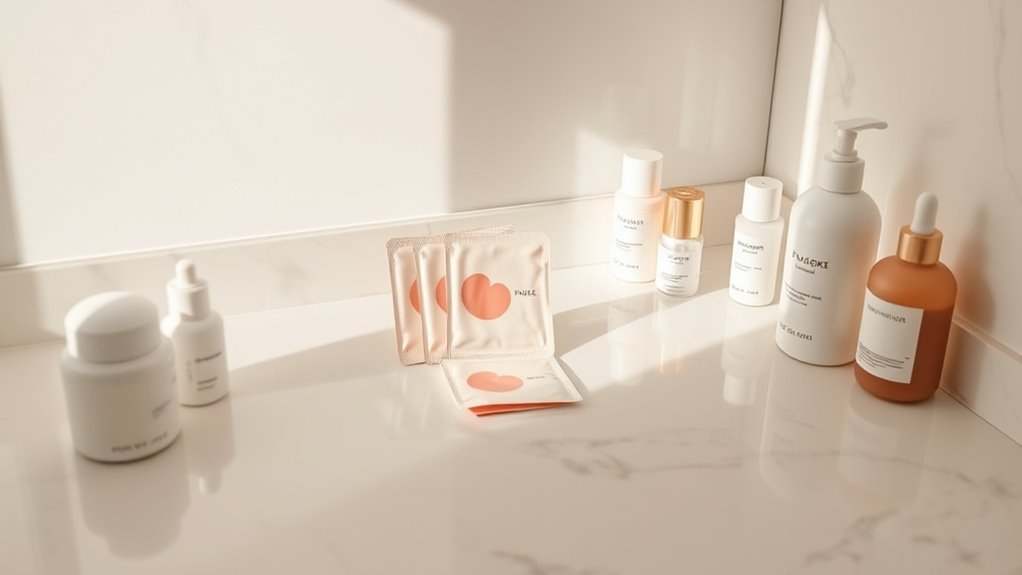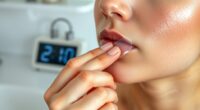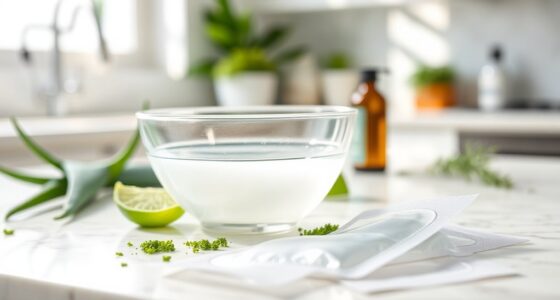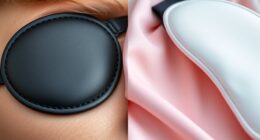Pimple patches are best used on top of your skincare routine. They provide targeted treatment by absorbing fluid and reducing inflammation, while creating a barrier against bacteria. Applying them to clean, dry skin after your usual skincare steps enhances their effectiveness. With the right timing and ingredients, such as salicylic acid or tea tree oil, you can accelerate healing. Curious about maximizing your patch experience? There’s more to discover about integrating them seamlessly into your routine.
Key Takeaways
- Pimple patches should be applied after your skincare routine on clean, dry skin for maximum effectiveness.
- They act as a protective barrier, reducing the risk of infection and preventing scarring from picking.
- Hydrocolloid patches maintain moisture, promoting faster healing while absorbing excess oil and pus.
- Patches are best used for surface-level breakouts, while deeper cystic acne requires different treatments.
- Choose patches based on skin type and specific needs, integrating them into your overall skincare regimen.
Understanding Pimple Patches and Their Functionality
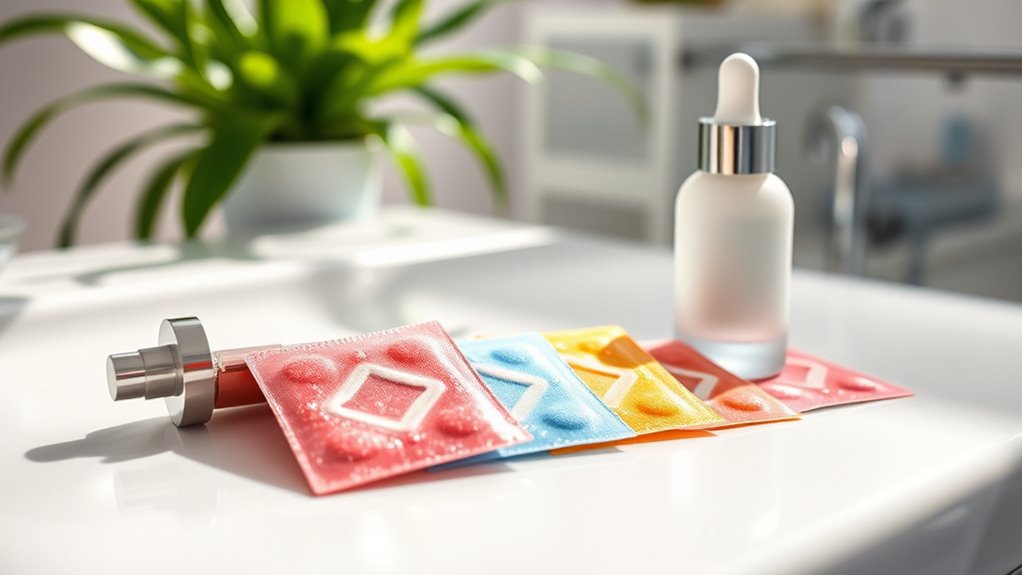
When you deal with breakouts, pimple patches can be a game-changer. These patches are typically made from hydrocolloid, a material that absorbs excess oil and pus while creating a moist environment for healing. Hydrocolloid prevents scab formation by keeping the affected area hydrated, which further aids in the healing process. By forming a barrier against bacteria and reducing the urge to pick, they help prevent scarring and speed up recovery. Some patches even come infused with active ingredients like salicylic acid or tea tree oil, enhancing their effectiveness against inflammation. Additionally, using patches designed for cystic acne treatment can provide targeted relief for stubborn breakouts.
While they’re excellent for whiteheads and surface-level pimples, they’re not suitable for deeper cystic acne. Remember, they’re a spot treatment and won’t prevent future breakouts, so consider using them alongside your regular skincare routine for the best results.
The Optimal Timing for Patch Application

To get the most out of your pimple patches, timing their application is essential. Start by applying them to clean, dry skin after you’ve completed your skincare routine. This prevents other products from interfering with the patch’s effectiveness.
For standard patches, aim for a wear time of 4 to 8 hours, while overnight use can be extended to 8 to 12 hours. If you’re dealing with stubborn breakouts, you can wear the patch for up to 24 hours. Remember to replace the patch once it turns opaque, indicating it’s reached maximum absorption. Additionally, these patches create a moist environment that speeds up healing, helping to prevent scabs and scars.
Applying patches as soon as pimples appear can help prevent picking and irritation, giving you the best chance for quick healing.
Key Benefits of Using Pimple Patches

Pimple patches offer several key benefits that make them a must-have in your skincare arsenal.
They’re incredibly easy to apply and discreet, allowing you to treat pimples without drawing attention. You can save time with these patches, as they provide a quick solution for targeted treatment, even while you sleep.
They act as a protective barrier, preventing you from picking at your pimples and reducing the risk of infection. Many patches maintain skin hydration, promoting faster healing by creating a moist environment that aids in healing.
With soothing ingredients, they minimize inflammation and redness, enhancing your skin’s comfort.
Exploring Different Types of Pimple Patches

Having explored the key benefits of pimple patches, it’s time to look at the different types available on the market.
You’ll find non-medicated hydrocolloid patches, ideal for surface-level pimples. They absorb excess fluid and protect against bacteria while being clear and discreet.
Medicated patches, on the other hand, contain active ingredients like salicylic acid or tea tree oil to target early-stage pimples, reducing inflammation effectively. Pimple patches are designed for targeted, convenient, and discreet treatment of breakouts.
Medicated patches utilize powerful ingredients like salicylic acid and tea tree oil to effectively combat early-stage pimples and reduce inflammation.
If you’re dealing with deep-seated acne, consider microneedling patches, which use tiny needles to deliver treatments directly into the skin.
Finally, pay attention to adhesive types—silicone and hydrogel offer the best adherence.
Choosing the right patch tailored to your skin’s needs can make all the difference in your acne treatment journey.
Evaluating the Effectiveness of Pimple Patches

How effective are pimple patches in your skincare routine? These patches, thanks to their hydrocolloid properties, create a gel-like barrier that absorbs excess fluid and reduces inflammation, making them great for open acne.
They not only prevent you from picking at your pimples, reducing the risk of scarring, but they also help keep the area moist for quicker healing. When applied to clean, dry skin, they can work alongside treatments like benzoyl peroxide or salicylic acid for even better results. Additionally, hydrocolloid patches are designed to soak up infected fluid, enhancing their effectiveness.
Users often notice a reduction in the size and redness of pimples within hours. While they’re not a substitute for chronic acne treatments, they can definitely boost your confidence by making blemishes less visible.
Limitations of Pimple Patches

While pimple patches can effectively manage certain types of acne, they come with limitations that users should consider.
For starters, they’re not effective for cystic acne, nodules, or blackheads, as these require deeper treatments. If you have sensitive or extremely oily skin, you might experience irritation or diminished adhesion. Pimple patches typically target specific types of acne, making them less suitable for broader skin concerns.
Remember, pimple patches are designed for spot treatment, not for preventing future breakouts or addressing hormonal imbalances. Lifestyle factors like diet and stress also remain unaffected.
Additionally, frequent use can lead to skin irritation, and some patches may leave residue upon removal.
Finally, consider the environmental impact and cost of using disposable patches regularly, as these factors add to their limitations.
How to Choose the Right Pimple Patch for Your Skin

When selecting the right pimple patch for your skin, it’s essential to take into account your specific acne type and skin condition.
For surface-level pimples, hydrocolloid patches effectively absorb excess fluid. If you’re dealing with early-stage acne, consider patches containing salicylic acid for exfoliation. Hydrocolloid patches are known for their ability to speed up healing processes by drawing out impurities from the skin.
Hydrocolloid patches are ideal for surface-level pimples, while salicylic acid patches help with early-stage acne.
For deeper cystic acne, microneedle patches deliver powerful ingredients right where they’re needed. If your skin is sensitive, choose hypoallergenic options, while oily skin can benefit from hydrocolloid patches that soak up excess oil.
Dry skin types should look for patches infused with hyaluronic acid for added moisture. Finally, make sure you pick the right patch size: small for individual spots, and medium or large for clusters.
This tailored approach maximizes effectiveness.
The Role of Pimple Patches in Your Skincare Routine

Pimple patches play a significant role in your skincare routine by acting as protective barriers for blemishes while delivering active ingredients directly to the affected area.
Many patches contain beneficial ingredients like salicylic acid or tea tree oil, which target acne effectively. Their hydrocolloid nature absorbs excess oil and dirt without harsh chemicals, making them suitable for various skin types and blemish sizes. Hydrocolloid patches shield spots, providing a moist and clean environment that promotes healing.
By applying these patches, you can reduce pimple size and redness, promote healing, and prevent picking, which minimizes the risk of scarring. They keep the affected area clean and reduce bacterial exposure.
For best results, integrate them into your routine by applying after cleansing, preferably overnight, to maximize their efficacy.
Tips for Maximizing Pimple Patch Efficacy

To maximize the efficacy of pimple patches, it’s essential to choose the right one for your skin type and the specific blemish you’re targeting.
Opt for hydrocolloid patches if you have sensitive skin, or medicated patches with salicylic acid for inflamed pimples. Different patches serve different purposes which means selecting the appropriate type can significantly impact your results.
Choose hydrocolloid patches for sensitive skin, or salicylic acid patches for treating inflamed pimples effectively.
Cleanse your face gently and let your skin dry completely before application. Center the patch over the pimple and press gently to secure it.
Apply at night for best results and avoid heavy moisturizers beforehand. Keep the patch on for six to eight hours, and replace it when it turns white.
Finally, resist touching the patch to maintain its adhesion and effectiveness. By following these tips, you’ll enhance your pimple patch experience greatly.
Real-Life Experiences: Pimple Patches in Action
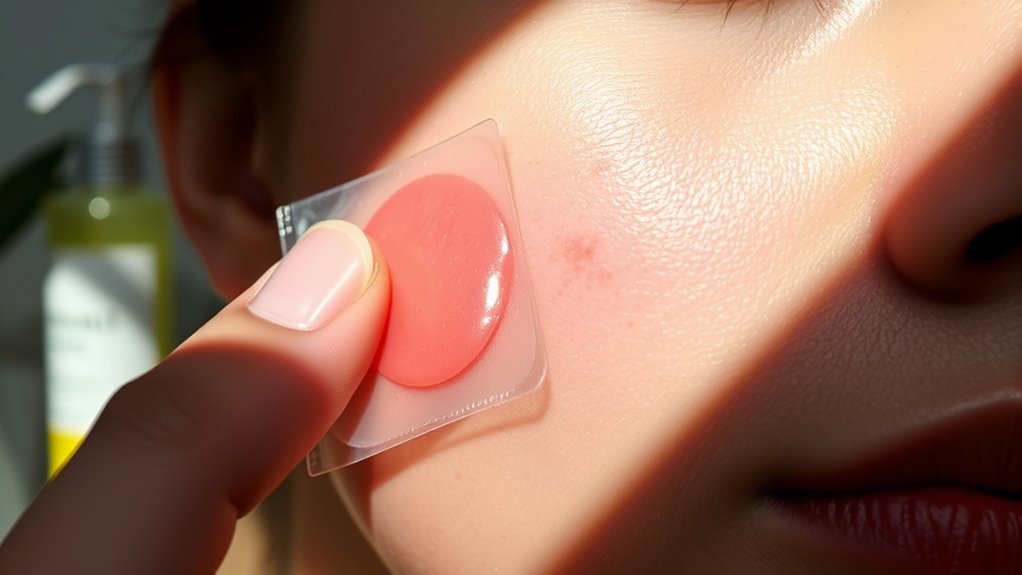
How effective are pimple patches in real life? Many users find that hydrocolloid patches greatly reduce the size and redness of surface-level pimples, especially whiteheads and inflamed spots.
By absorbing fluid and preventing you from picking, they can also minimize the risk of infection and scarring. You might notice improvements overnight, thanks to the patches creating a protective environment. Additionally, these patches are designed to allow skin to heal naturally while minimizing infection risk.
For added effectiveness, look for patches infused with salicylic acid or tea tree oil. However, remember that they’re less effective for blackheads or deep cysts.
Frequently Asked Questions
Can Pimple Patches Cause Irritation or Allergic Reactions?
Yes, pimple patches can cause irritation or allergic reactions.
If you have sensitive skin, the adhesives or materials in patches might trigger redness, itching, or peeling. Ingredients like salicylic acid or sulfur can also irritate your skin.
It’s important to choose the right patch for your skin type and always clean your skin before applying.
If you experience severe reactions, consider consulting a dermatologist for advice tailored to your specific needs.
How Long Should I Leave a Pimple Patch On?
You should leave a pimple patch on for about 4 to 8 hours for the best results.
If you’re treating more severe acne, you can keep it on for up to 24 hours.
Make sure to replace the patch once it becomes saturated.
Remember, individual skin types may affect how long it works, so always follow the instructions provided with the patch.
You’ll likely see results after just a few hours!
Can I Reuse Pimple Patches?
Imagine trying to sip water from a sponge that’s already soaked—it’s just not effective.
You can’t reuse pimple patches. Once they absorb fluids and collect bacteria, they lose their potency and can irritate your skin.
Each patch is designed for one-time use to guarantee maximum absorption and hygiene.
Using a fresh patch each time keeps your skin protected and promotes healing.
Are Pimple Patches Safe for Sensitive Skin?
Yes, pimple patches can be safe for sensitive skin, especially if you choose the right type.
Hydrocolloid patches are gentle and typically don’t irritate. However, always check for potential allergens in the adhesive and active ingredients like salicylic acid or tea tree oil.
Before applying, make sure your skin is clean and dry, and consider patch testing first.
After use, don’t forget to moisturize to keep your skin hydrated.
Do Pimple Patches Work on All Types of Acne?
Pimple patches work well on surface-level acne, but they won’t help with everything.
They’re effective for whiteheads and pustules, absorbing moisture and reducing inflammation.
However, they struggle with deeper cystic acne and blackheads, as they lack the necessary fluid.
If you’re dealing with mild breakouts, they can speed healing and prevent picking, but keep in mind their limitations.
Conclusion
In the grand arena of skincare, pimple patches stand as your trusty sidekick, ready to battle blemishes with precision. While they aren’t a cure-all, their strategic application can transform your routine. By understanding their function and choosing wisely, you can harness their power for clearer skin. So, don’t underestimate these little heroes; integrate them into your regimen and watch as they help you conquer acne like a true warrior in the skincare domain.
